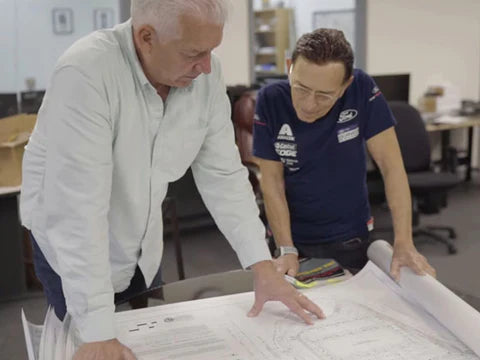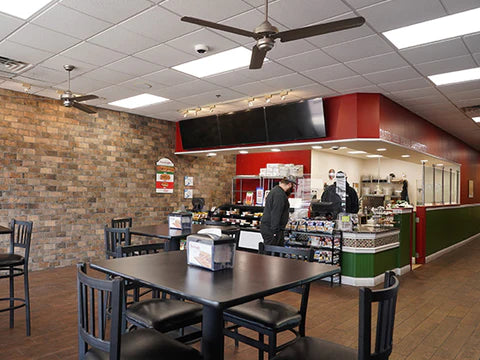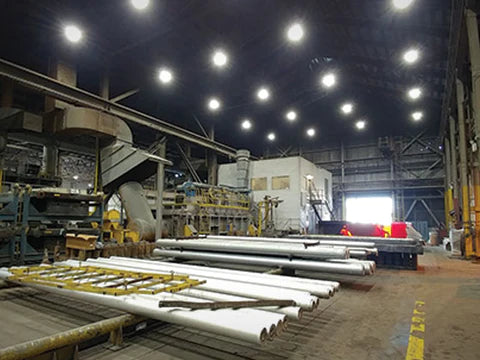Top LED Lights For Hospitals and Healthcare Facilities
Hospitals and other healthcare facilities require specific types of lighting. From waiting rooms, to patient suites, to hallways, to operating rooms, complex and varying requirements must be met. Our team is ready to provide the best lighting solution for each application, meeting the highest quality and performance standards to help with patient healing, staff comfort, and technical accuracy.
Properly Lighting General Hospital Spaces
Areas such as patient exam rooms, corridors, nursing stations and individual offices are more general spaces, making it a bit easier to determine and source their lighting. However, aspects like color rendering, color temperature, and light levels, are still important to get correct so that specific tasks can be completed easily.
Important Aspects of General Hospital Lighting:

- Color Rendering - Lighting with a high CRI (color rendering index) will ensure colors appear true-to-life. This lighting aspect is important in healthcare because the color of a device, medication, or other objects can be critical to know quickly—especially in fast-paced, high-stress situations.
- Color Temperature - The CCT (correlated color temperature) of a light greatly impacts the people who experience it. The standard color temperatures for indoor lighting are 3500K (Warm White), 4000K (Neutral White), 5000K (Cool White), and 6000K (Cold White). CCTs that are a lower number contain more yellow as an undertone while numbers higher on the scale lean blue. Lights that are warmer in tone will create a more comforting and relaxing environment, and lights that are cooler in tone will promote an atmosphere of concentration and focus.
- Light Levels - Each space in a healthcare facility will also need specific levels of light. Some spaces will need more brightness and will call for fixtures with higher lumen outputs. Other spaces, especially smaller rooms with lower ceilings, will not need as high of an amount. A lighting expert can best determine the precise levels of light each area will need, so that no light is wasted, no light is too blinding, and no dark spots are created.
Types of Lighting for General Areas of a Hospital:
- Indirect Troffer Lighting
- Help ensure that people looking up at the ceiling from hospital beds don’t experience glaring light in their eyes.
-
LED Strip Lights
- Can be used to retrofit existing indirect fluorescent fixtures, which is more cost effective than a full replacement while providing a lighting and efficiency upgrade.
- Cove Lighting
- Great for nurses’ stations because it brightens walls and/or ceilings and is especially effective when paired with under-cabinet lighting for tasks that require careful attention.
Properly Lighting Specialty Healthcare Spaces

While there is some overlap between the lighting of general spaces in a healthcare facility and more specialty applications, certain spaces do require specific types of lighting. For example, units with MRI machines require lighting made exclusively with non-ferrous materials (aka without iron or steel). It is important to source the correct products for each specialty location, and a lighting expert can be invaluable to this process.
Types of Lighting for Specialty Medical Facilities:
- Vandalism-Resistant Lighting
- Meets the impact-resistant, tamper-resistant, and anti-ligature needs of a variety of healthcare applications, especially for behavioral units and emergency rooms.
- Surgical Suite Lighting
- Sealed against infectious contaminants, will not disturb sensitive electrical devices, and addresses the requirements of all 3 surgical zones; includes specialized recessed troffers, specialized downlights, motorized lighting, and boom lighting.
- Non-Ferrous Lighting
- Built without iron or steel components for use in MRI units and spaces with similar needs.
- Lightings with UVC Cleaning Capability
- Safely clean the air and surfaces with germicidal light that can deactivate viruses, molds, and other contaminants. Models available for use in occupied or unoccupied spaces.
Cost-Saving LED Lighting at Girard Medical Center
Our team at ELEDLights recently completed a revamp of the interior and exterior lighting at Girard Medical Center in North Philadelphia. During this project, it was taken into consideration that this hospital needed to prioritize cost-saving techniques while still meeting their needs for high-quality lighting. To meet these requirements, one solution our team proposed (and that Girard decided to go with) was to use 4ft LED strip lights to retrofit existing fluorescent fixtures.
The existing fixtures were indirect fluorescent troffers, which can be expensive to replace. So, rather than have to pay for a full replacement, Girard elected to retrofit them. The cost associated with this retrofit project was much lower than the alternative, and their upfront costs were actually mitigated even further by the utility rebates they received. After rebates, they ended up paying just $5 per fixture!

Before making the switch to LED strip lights, Girard Medical Center was spending approximately $5,143 per month on energy expenses of their fluorescent troffers. Now, their monthly energy costs are estimated to be $1,371. That’s an average savings of 73% each month!

The total cost of their LED strip lighting upgrade would have been approximately $44,640 before rebates. After rebates, their upgrade cost was just $7,440! With the energy savings alone, this upfront cost could be paid off in only 2 months. After that, Girard Medical Center will enjoy years and years of straight savings.
Check out our video to learn more about this application!

 215.355.7200
215.355.7200




